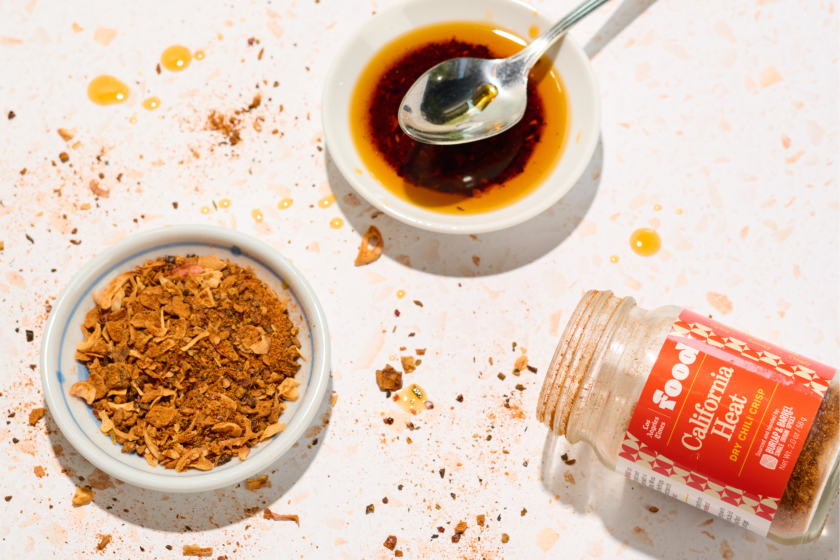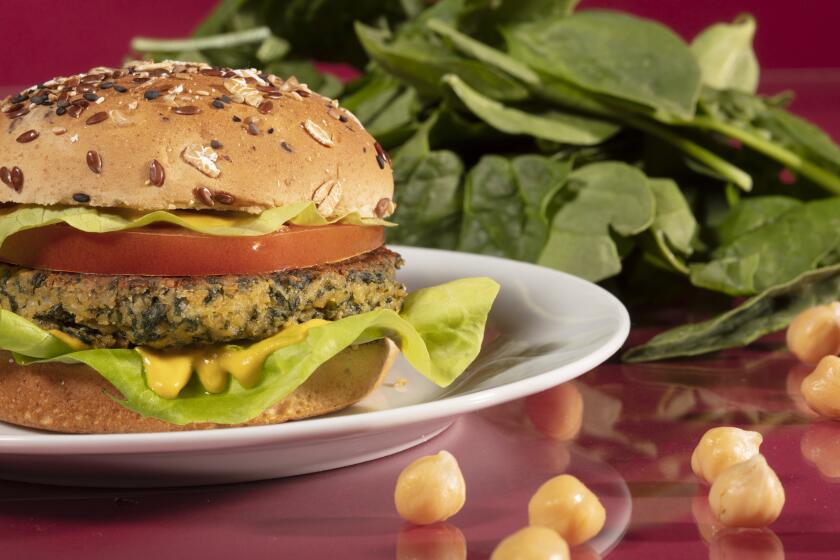'Spanglish' BLT with fried egg and melted cheese
Movies have changed since the days when a man in an apron was a character experiencing a masculinity crisis. Does anyone remember the sad, sad sight of Jim Backus, James Dean’s dad in “Rebel Without a Cause” or the lovesick Edward G. Robinson in “Scarlet Street”? Today, any movie hero meant to be either sensitive or worldly had better know something about food. He can even wear an apron.
In “Spanglish,” the latest from director James L. Brooks, Adam Sandler plays John, a devoted husband and father who cries just thinking about how much he loves his daughter. John is a chef. Not just a chef, but the best chef in the country (according to the New York Times, which in the world of this film reviews Los Angeles restaurants, and which raises the question: What are we, chopped liver?). Thanks to a four-star review from that paper, John’s Los Angeles eatery becomes incredibly hot and twice as lucrative, and so he does what any big-shot chef would do. He immediately gives away 20% of the business to his chef de cuisine. He doesn’t want to give up an iota of his family time.
It’s hard to imagine Cary Grant, Dana Andrews or Gary Cooper playing a chef back in the day, but a chef is now an acceptably glamorous profession for the hero of more than one major motion picture and possibly a glossy TV show. In “The Great New Wonderful,” a film in post production and directed by Danny Leiner, Maggie Gyllenhaal plays a high-end cake designer whose sweets are extremely expensive works of art. And Darren Star is developing a TV pilot for Fox called “Kitchen Confidential,” based on Anthony Bourdain’s 2000 best-selling memoir.
Bourdain, of course, is a bad boy writ large -- a drug-taking, lusty, foul-mouthed truth-teller of a chef. “Sex and the City” creator Star, who describes himself as “a passionate foodie,” has been thinking about a chef as the lead character for a TV show for a few years. And he believes he’s found the right one at the right moment.
“I see it as ‘Shampoo’ set in a restaurant,” says Star, who uses the book as a jumping-off point for the pilot. He describes his hero as a guy who has been a comet in the food world, a substance abuser who lives life to the edge. He’s now getting a second chance, though he’s still struggling with his demons. “To be the chef of a hot restaurant is to walk a tightrope,” says Star. “You have to balance the demands of the job with the big temptations that come with celebrity. You have all of these goodies at your feet. You have to stay up without falling prey to all of the temptations out there that were not out there for chefs 25 years ago.”
There is room for several flavors of chefs; Bourdain is the anti-Adam Sandler. In “Spanglish,” John is such a model father and husband that he does not sleep with Flor (Paz Vega), the adored, adoring and stunning housekeeper, even though Flor is unmarried and John’s pathologically selfish wife has just confessed she is sleeping with another man (this kind of sexual renunciation has not been seen since Henry James was alive and writing). And the movie’s point is not that John is a wimp. The movie’s point is that he is an all-around great guy, a hero. Look at the tagline in the ad: “Every family has a hero.” And everyone in the picture is looking at him.
Brooks chose chef as a profession for John not necessarily for food-related reasons but “because I wanted him to have earned money through a gift” and not because of an ambition to make money. Brooks is a fan of Thomas Keller, and he aimed to duplicate the feel of the kitchen at the French Laundry, which both Brooks and Sandler spent time observing. “I always thought kitchens were noisy places,” says Brooks. “His kitchen is serene. There’s an enormous amount of respect in there; everyone addresses everyone as ‘chef.’ ” Keller also made it onto the “Spanglish” set.
Keller’s presence ensured a certain amount of authenticity. At one critical juncture, John is in his kitchen at home making himself a BLT with melted cheese and an over-easy egg; Keller provided the recipe. The loving shots of sandwich prep signal how important this snack is to John. You really want to eat this sandwich, and this is a sandwich you need to eat right away, while the egg is still warm. The payoff for this bit of food porn is a scene of sandwich-interruptus. Flor enters, angry, just as John is moving the sandwich to his mouth for that first perfect bite. While she vents (through her daughter, acting as translator), he throws anguished, aching glances at the sandwich he is too polite to eat.
This scene is in fact more convincing in its feeling for food than the more crucial (albeit chaste) seduction-cooking scene that comes later. In that scene, John takes Flor to his empty restaurant at night (must be a Monday), the interior of which is physically inspired by the French Laundry. There, John fixes Flor a plate (short ribs, though we see him making lamb chops) that looks polished and professional. It does not bespeak passion. “I will remember every taste forever,” Flor tells John. Judging from the plate, this is doubtful, but she is a woman in love.
Wes Anderson’s endearing film “The Life Aquatic with Steve Zissou” makes it clear that being food- and wine-savvy is de rigueur for the worldly movie character today. Bill Murray’s character is a hero for the new century, a pensive, charming and imperfect man of the world (above and below sea level) with a deep appreciation for life’s pleasures. Zissou scolds a waiter who dares to pour the wine for his younger companion instead of for him. “He doesn’t know anything about wine,” Murray sneers and throws the waiter one last angry glance before sniffing the wine himself.
When we get a tour of Zissou’s ship, we’re informed that the kitchen is the most technologically advanced room in the vessel. And when “team Zissou” raids the richer ship of arch rival Hennessey (Jeff Goldblum), the only item Zissou shows any real interest in is the cappuccino maker, which he promptly steals. We get only one glimpse of a crew meal aboard this enchanted ship -- platters of lobster and glasses of Moet Champagne.
Of course, the surprise hit of the year is “Sideways,” the most wine-drenched movie ever. This is a film by Alexander Payne (“About Schmidt,” “Election,” “Citizen Ruth”), so its protagonist is not of the heroic caliber of “Spanglish” or of the fantastical dimension of “The Life Aquatic.” The nebbishy Miles (Paul Giamatti) is hardly a hero; he’s a grown man who steals money hidden in his mother’s drawer, for God’s sake. But he does manage to be touching and to get better, once he establishes intimacy with a waitress named Maya (Virginia Madsen) through talk of wine.
“Can I ask you a personal question?” Maya says to Miles. “Why are you so into Pinot?” Their tender seriousness as they taste a Fiddlehead Sauvignon Blanc on their first date and shyly identify “little hints of clove” tells us that this conversation will serve as a profound binding for them, as a way for each to reveal him and herself. Taste is a matter of consequence for Miles and for Maya.
When he describes his love of Pinot, it is heartbreakingly clear that Miles is in fact describing himself to her, describing how he would like to be loved. “It’s a hard grape to grow,” he says. “It’s not a survivor like Cabernet, which can just grow anywhere, thrive even when it’s neglected. In fact it can only grow in these really specific, little tucked-away corners of the world. And only the most patient and nurturing of growers can really do it.”
*
Cuisine on stage
Playwrights too are using knowledge of food to reveal class, culture and taste. In “The Paris Letter,” which just finished its run at the Kirk Douglas Theatre in Culver City and will arrive at New York’s Roundabout Theatre Company this summer, Jon Robin Baitz uses food awareness to signal personal integrity. His protagonist is a man in moral trouble. Sandy (Ron Rifkin) has denied his own artistic calling by going into his father’s finance business and has denied his sexual calling by going into therapy to “cure” his homosexuality and by marrying Katie. This is a man who has worldly success but is damned as surely as Faustus.
By contrast, the two people closest to him, Katie and his best friend Anton, have maintained the soundness of their souls. Both have been cooks and bistro owners. A dinner guest finishing his plate of bay scallops pan-fried with capers, sage and borlotti beans asks Katie, “How do you do this? OK, it’s not like I haven’t had any of this elsewhere, but it’s like you have some sort of freaky magic.”
Katie responds with an environmentally aware answer: “Where are the scallops from? Where are all the ingredients from? How do things go together? It’s in having relationships. Fishermen. Cultivating. Respect.” Katie’s guest, a money man who turns out to be the villain of the piece, doesn’t even hear her response.
Naturally, the emergence of the food and wine worlds as movie backdrops will test the credulity of any food-industry insider.
In “Sideways,” for instance, Miles almost makes a mantra of loving Pinot and hating Merlot, and he slights Cabernet Franc as well (Pinot sales in New York City went up in the film’s wake and Merlot may be experiencing a bit of a backlash). But in the film’s coup de grace, Miles finally drinks his prized bottle of 1961 Cheval Blanc, the one he’s been saving for too long, a wine that has in fact become a metaphor for Miles and his habit of letting life pass him by. The wine is made from, guess what -- Cabernet Franc and Merlot, an irony not commented on by the filmmakers.
Furthermore, going back to “Spanglish,” the New York Times does not review, let alone hand out stars, to Los Angeles restaurants, thank you very much. Any major chef in this city would speak and understand “kitchen Spanish,” but Adam Sandler’s John does not.
But just as it’s possible to analyze a wine and miss its pleasure, people who assess fiction strictly for accuracy invariably miss larger points. As food knowledge saturates the culture, the coming years will bring more and better opportunities for foodies to show off their knowledge and miss the point. Expect a satire on the subject in 2006.
Cook the bacon until crisp, drain on paper towels and set aside.
Place the slices of cheese on one slice of the toasted bread and place in a toaster oven or under a broiler to melt the cheese.
Spread the other slice of toast with the mayonnaise, top with the cooked bacon, the sliced tomato and the lettuce.
In a nonstick skillet, melt the butter over medium heat. Fry the egg, turning over briefly when the bottom is set. (Keep the yolk runny.)
Slide the finished egg on top of the lettuce. Top with the other slice of toast, melted cheese side down. Place the sandwich on a plate and slice in half, letting the yolk run down the sandwich.
Get our Cooking newsletter.
Your roundup of inspiring recipes and kitchen tricks.
You may occasionally receive promotional content from the Los Angeles Times.















